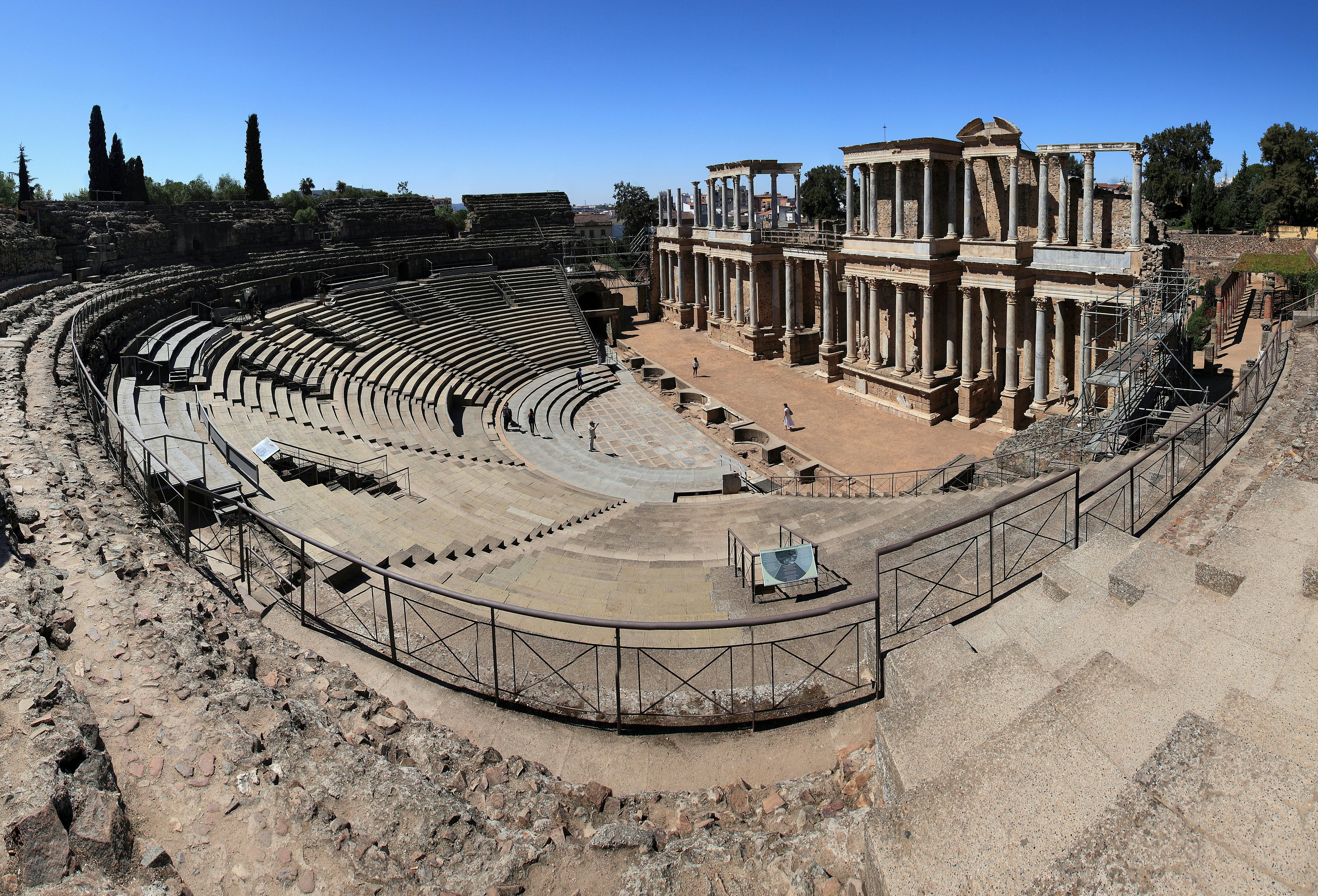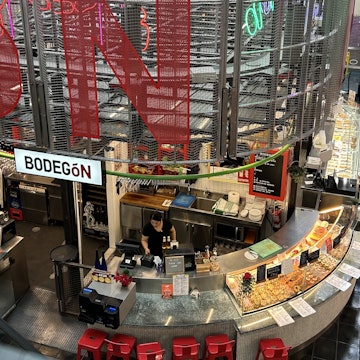

The rooftops of picturesque Cáceres. joserpizarro / Shutterstock
Often overlooked and underrated Extremadura is, in fact, one of Spain’s most fascinating regions, a mix of world-changing history and contemporary culinary delights.
This Portuguese-border-hugging homeland of many a conquistador is a place where the past lingers. Venture here and you’ll uncover time-warped old towns, rickety castles, serene monasteries, beautiful countryside and mouthwatering regional cuisine.

Our seven-day itinerary assumes you’ll be setting off for Extremadura from Madrid, from which it's three hours’ (300km) drive southwest to Cáceres. You could also start from Seville and travel north, or from Salamanca, and head south. The best months for exploring are April, May and September. Though it’s possible to access most of these destinations by bus or train, travelling by car gives you significantly more freedom and flexibility.
Day 1: magical Cáceres
Whether it’s the Plaza Mayor’s urban buzz or the mellow strum of a guitar along the twisting streets of the evocative World Heritage-listed Ciudad Monumental (Monumental City), Cáceres has its own magical atmosphere.
Plunge into the old town through the 18th-century Arco de la Estrella and breakfast at artsy Los Siete Jardines. Wander past the intricate stone-cut exteriors of grand Renaissance mansions and palaces and explore the Plazas de Santa María, San Jorge and San Mateo. The excellent Museo de Cáceres deserves a visit, and you can tour the lavish Palacio de los Golfines de Abajo before climbing the 12th-century Torre de Bujaco.
Cáceres rolls out some of Extremadura’s most delicious food offerings. Feast on elegantly prepped Spanish-international tapas, like tenderloin in creamy local Torta del Casar cheese, at chic, jam-packed old-town tapería (tapas bar) La Cacharrería. Extremadura’s finest dining experience is to be had at luxe Atrio, and afterwards you can finish off the evening with cocktails between ivy-clad walls at El Corral de las Cigüeñas or artisan Extremaduran beers at Las Claras.
Sleep
All-white Atrio is a dream of a five-star old-town design hotel. Hotel Casa Don Fernando has stylish modern rooms right on the Plaza Mayor.
Day 2: into the wild - Parque Nacional de Monfragüe
Start early: it’s time to explore the dramatic undulating expanses of the 180-sq-km Parque Nacional de Monfragüe. Home to over 75% of Spain’s protected bird species, Monfragüe is an outstanding birdwatchers’ haven. It’s also a vast outdoor playground threaded with enjoyable walking trails.

Catch a colony of griffon vultures patrolling the skies from the sensationally scenic Mirador Salto del Gitano and Castillo de Monfragüe. Other local feathered friends include endangered Spanish imperial eagles, black storks or black vultures.
The park’s main visitor office is in Villareal de San Carlos, 75km northeast of Cáceres. Drop in at Villareal’s Restaurante Monfragüe for typical meat-mad Extremaduran cooking. On the park’s south side, Torrejón el Rubio also has an information centre.
Sleep
Monfragüe is an easy day trip from Cáceres, but if you fancy staying overnight, Villareal’s Casa Rural Monfragüe offers colourful rustic rooms.
Day 3: Trujillo and the Americas
Whizz 52km east from Cáceres to Trujillo, from where Spain’s most famous conquistadors marched off to the New World in the early 16th century.
No surprise then, given its past, that timeworn Trujillo sparkles with splendid baroque and Renaissance palaces, elaborate stone-carved facades, concealed Moorish-era aljibes (cisterns), twirling church spires and lush gardens bursting with bougainvillea.
Fuel up on the majestic Plaza Mayor, under the piercing gaze of Trujillo’s towering, bronze-sculpted Francisco Pizarro – Mesón La Troya is legendary for its giant portions of thoroughly Extremaduran cooking – then begin exploring the steep, walled old town. The 13th-century Iglesia de Santa María la Mayor and the 15th-century Casa-Museo de Pizarro are worth seeking out for the lowdown on the five Pizarro conquistador brothers. Your final stop should be the mysterious 10th-century Moorish castle crowning Trujillo before dinner at El 7 de Sillerías, which delights with high-quality, local-style meaty meals.
Sleep
Posada Dos Orillas has handsome colonial-inspired rooms inside a revamped 15th-century house.
Day 4: gracious Guadalupe
Today, you’re embarking on a 78km pilgrimage east from Trujillo to Guadalupe. Your reward? The glorious, glittering Real Monasterio de Santa María de Guadalupe, built on the spot where legend has it that a 14th-century shepherd unearthed a cedar-wood carving of the Virgin. Extremaduran conquistadors took the cult of the Virgen de Guadalupe to the New World, making her the religious patron of much of Latin America. Pilgrims still flock to Guadalupe from across the globe for the chance to kiss the statue’s mantle.

Tour the monastery and its extravagant collection of art, jewels, illuminated manuscripts and other riches. You’ll also see two exquisite cloisters, one late-14th-century Mudéjar, the other Gothic.
Eat and sleep
The Hospedería del Real Monasterio lets you dine and snooze in antiquated, character-packed rooms lining the monastery’s gorgeous Gothic cloister.
Days 5 & 6: Roman Mérida
Spin 125km southwest from Guadalupe to Mérida, Extremadura’s capital. Crammed with Spain’s finest Roman relics – Mérida once ruled the Roman province of Lusitania – you’ll need two days to explore thoroughly. A combined €12 ticket gives you access to most sights.

Start with the stunning Museo Nacional de Arte Romano, before hitting the show-stopping, 6000-person Teatro Romano, built in 15 BC. Head downhill, past the 1st-century-BC Templo de Diana, to admire the elegant Puente Romano, then fast forward nine centuries to the adjacent Moorish Alcazaba. Nearby, El Trasiego delivers delicious contemporary cooking. Other historical treasures include the Acueducto de los Milagros, the Cripta de Santa Eulalia and the 1st-century AD Roman circus.
Come dinnertime, classy Tábula Calda concocts Spain’s culinary favourites with homegrown ingredients, or La Bodeguilla entices with Extremaduran classics, from succulent grilled meats to platters of the finest jamón (cured ham).
Sleep
Crash at fabulously fresh Hostal Emeritae or Capitolio’s multi-coloured self-catering apartments.
Day 7: south to Zafra
From Mérida, it’s 60km south to sultry Zafra. On the way, swing by the recently restored 15th-century Castillo de Feria, which flourished under the formidable local Feria dynasty and enjoys wraparound panoramas from its scenic hilltop location.

Moorish-origin Zafra has a jewel of a sun-bleached, flower-filled old town. Explore the still-active, 15th-century Mudéjar-style Convento de Santa Clara, where the Feria family is entombed. Lunch on tapas under the arches of the palm-dotted Plaza Grande and the adjoining Plaza Chica. Then visit the spectacular marble-clad Renaissance patio of Zafra’s commanding castle, now a parador (luxurious state-owned hotel). Dine on fine traditional-style meats and outstanding desserts at La Rebotica.
Round your Extremaduran expedition off some 45km south from Zafra in Monesterio. This unassuming town produces some of Spain’s most garlanded jamón – and also hosts an exceptional Museo del Jamón.
Sleep
Be king (or queen) of the castle at the beautifully refurbished 15th-century Parador de Zafra.
















